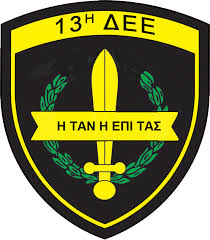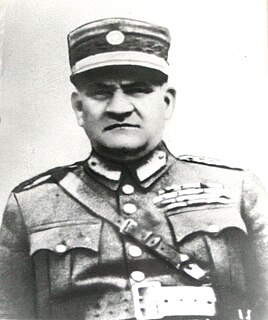The Kydoniai Division (Greek : Μεραρχία Κυδωνιών) was an infantry division of the Hellenic Army, active in 1920 during the Asia Minor Campaign.

Greek is an independent branch of the Indo-European family of languages, native to Greece, Cyprus and other parts of the Eastern Mediterranean and the Black Sea. It has the longest documented history of any living Indo-European language, spanning more than 3000 years of written records. Its writing system has been the Greek alphabet for the major part of its history; other systems, such as Linear B and the Cypriot syllabary, were used previously. The alphabet arose from the Phoenician script and was in turn the basis of the Latin, Cyrillic, Armenian, Coptic, Gothic, and many other writing systems.

The Hellenic Army, formed in 1828, is the land force of Greece. Along with the Hellenic Air Force (HAF) and the Hellenic Navy (HN), it makes up the Hellenic Armed Forces. It is currently the largest branch of the three. The army is headed by the chief of the Hellenic Army General Staff (HAGS), which in turn is under the command of Hellenic National Defence General Staff (HNDGS).
Following the Greek landing at Smyrna on 2 May 1919, [1] and the establishment of an occupation zone in Ionia, the Kydoniai Division, named after the Greek name of the town of Ayvali, began formation in January 1920. Its core was provided by the independent 31st Infantry Regiment at Lake Doiran, the 32nd Infantry Regiment detached from the 8th Infantry Division at Ioannina, and the Smyrna Guard Regiment, which was renamed into the 33rd Infantry Regiment. Following completion of its formation in February, the division became part of the Smyrna Army Corps. The division's first and only commander was Colonel Alexandros Othonaios.

The Greek landing at Smyrna was a military operation by Greek forces starting on May 15, 1919 which involved landing troops in the city of Smyrna and surrounding areas. The Allied powers sanctioned and oversaw the planning of the operation and assisted by directing their forces to take over some key locations and moving warships to the Smyrna harbor. During the landing, a shot was fired on the Greek 1/38 Evzone Regiment and significant violence ensued with Greek troops and Greek citizens of Smyrna participating. The event became important for creating the three-year-long Greek Occupation of Smyrna and was a major spark for the Greco-Turkish War (1919–1922).

Ionia was an ancient region on the central part of the western coast of Anatolia in present-day Turkey, the region nearest İzmir, which was historically Smyrna. It consisted of the northernmost territories of the Ionian League of Greek settlements. Never a unified state, it was named after the Ionian tribe who, in the Archaic Period, settled mainly the shores and islands of the Aegean Sea. Ionian states were identified by tradition and by their use of Eastern Greek.

The 8th Infantry Division was an infantry division of the Hellenic Army.
In 14–20 September, the larger part of the division was shipped to Greece to provide guards for the November 1920 elections. The units that remained behind were amalgamated with the Crete Division that was transferred to Asia Minor at the same time. Following the elections, the division returned to Asia Minor, only to be abolished: the headquarters were merged with those of the Crete Division, while the 31st and 32nd Regiments were disbanded and merged into the 33rd Regiment, which also became part of the Crete Division, which in turn was renamed as the 5th Infantry Division.












